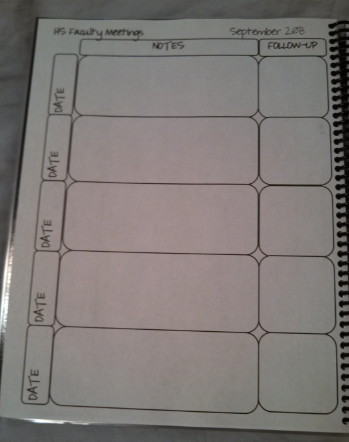I just posted about what I thought my ISNs were going to look like. This post is here and was written in July, but I didn't publish it until just now. I guess because I was a little bit scared. Anyway, as a follow-up to that post, I would like to share what our ISNs look like now that school has actually started.
Section 1.1 Set-Up
As part of our first day lesson, students created 5 numbers about them (I wrote about it here). Then this week we turned it into their back cover of their notebooks, like Kathryn (not me :) blogged about here. I didn't give the kids too much time to do it, so we were kind of rushed, but it helped that they already had their numbers picked out. Here is mine:
I'm working on covering all their notebooks with packing tape this weekend...what a job!The first thing we put into our notebooks is on page 5. I want to do a "title" page on page 1 and a table of contents on page 3, so I had them tape the syllabus onto page 5
And their first foldable was glued onto page 6. This is about classroom expectations for different ways that we learn in class. We filled out the inside one part at a time so it wasn't so overwhelming!
The on page 7, we started our first section. I decided to name all of my sections with an essential question. Mine aren't great EQs, but hopefully it will put pressure on me to continue improving them :) So on page 7 we taped in our tab and title:
The tab goes onto the back (so onto page 8) for extra support. Then also page 8 is our pocket for the section. So beautiful! Students have pretests in there already!On page 9 we put our section TOC and score tracker. I put the dates into the one that is in my notebook. But as I said in earlier posts, I use this same template for each student. I might show off my gradebook in more detail once I get going. Here is a place for students to track their own scores.
Those things will be at the beginning of each section: tab, pocket, and score tracker. We should be able to set them up a lot quicker from here on out since students are more familiar with it now. (I can hope at least, right?)
Section 1.1 Notes (Part 1)
Next comes our notes. I ended up deciding that it was OK to have input on the left and output on the right. Hopefully no one will be too upset. Here is our first page of "real" notes. Learning target at the top, vocab words flash-card style, and a student-created list of words to use when describing levels of accuracy and precision.
We did a station activity and students had to discuss all 6 stations, but only write a response to one. Then they handed them in. The next day I gave them back with comments. They glued their original onto the next page and wrote a better response below based off of my comments.
We have one more page of notes started. Here is what that page of notes looks like:
I have an idea about what we are going to do on the next page, but it's not fully developed. I better get going on that as it will be part of tomorrow's lesson!
Thanks to everyone whose blogs about their ISNs inspired parts of this post. Your ideas sat in my head for a long time before I could put them to work in a way that I felt was best for me. I am super excited about the notebooks and how it is already helping with organization! Students haven't yet asked me for any new copies of things I've handed out :)
Storage
Oh wait, I forgot to share how we are storing them. I am letting students keep them in the classroom. Mostly because I decided I didn't want to fight the homework battle any more so I will not be requiring students to complete much homework this year. I picked up a trick from our language arts teacher and loved that the notebooks fit in. Here is a pic from before school started:
Now all the folders have tabs with student names. I put them entirely in alphabetical order based on last name and placed the tabs in a certain spot based on which period they are in my class. Easy to find what I need quickly :) They put their notebooks in before they leave and pick them up again on their way into class the next day. It is also wonderful for getting needed papers to students who were absent...just slip it in the folder! But if using to store notebooks, you do need quite a few crates so they are not overstuffed. I have 4 for 87 students, but I think another one is in order...
Thanks for reading!
-Kathryn































